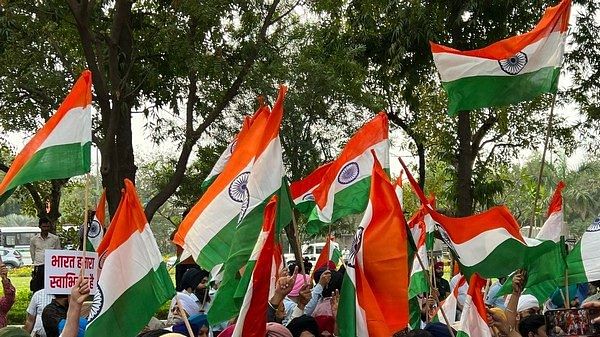The totally untenable and unpardonably anti-national demand for Khalistan is being raised again in some quarters. The earlier movement for a similar demand in the eighties, led by self-styled leader of the Sikhs, Bhindranwale ended in very tragic circumstances, leading to the assassination of then Prime Minister Indira Gandhi. The fact that the separatist movement lasted longer than estimated and had far reaching political and security impact, goes to prove that the demand was not merely home grown.
The Bhindranwale movement ran on the twin crutches of fundamentalism and terrorism. Amritpal, the self-styled religio-political upstart, formerly working as a driver in Dubai, is believed to have been recruited by the ISI of Pakistan with a mandate to revive the long-forgotten issue of Khalistan and vitiate the atmosphere in Punjab and the rest of the country.
The renewal of the Khalistan movement began with the Referendum 2020, which was spearheaded by several pro-Khalistan elements led by US-based secessionist group called Sikhs for Justice (SFJ), headed by one Gurpatwant Singh Pannun. The Referendum 2020 was used as a springboard to bring all pro-Khalistan groups under one umbrella. This attempt seems to have failed as the groups located in various countries had their own respective political agenda and were probably not willing to give up their local identity and political benefits and lose their local influence. Besides, some of them were probably not willing to surrender their ill-earned ‘donations’ to some entity in the US. Nevertheless, they could have maintained their networking and links intact, which could have formed the data base for the ISI to recruit new “leaders”.
Now declared a fugitive, Amritpal was anointed head of ‘Waris Punjab De’, which was founded by Punjabi actor and activist Deep Sidhu who died in a road accident in February 2022. The government should reopen the “accident” case and investigate if it was a case of murder due to political rivalry. It is notable that the anointment of Amritpal was held at Rode in Moga district, the native village of slain militant Jarnail Singh Bhindranwale. It is clear that the new outfit, conceived, funded and operated by the ISI, is the prime vehicle for reviving the demand for Khalistan which not only had lost its appeal but was rejected by the people with all the contempt it deserves.
Former pro-Khalistan leader and founder of Dal Khalsa Jaswant Singh Thakedar commented in an interview: “He (Amritpal Singh) himself, when he was in Dubai, was clean-shaven. He was not a (traditional) Sikh. He does not know anything about Sikh history. I must add that several Amritpal like him will come because those who are used by ISI, they are not used for lifetime.”
Also read: Prashant Kishor is right. Modi’s nationalist pitch makes him undefeatable, not Hindutva
The protest in foreign land
As was expected, the pro-Khalistan groups began to operate in silos toward one common goal that is to vandalise Indian government’s assets, offices and Hindu places of worship. The Honorary Consulate of India in Australia’s Brisbane city was forced to close down due to safety concerns after Khalistan supporters stormed the place and blocked the entry of the office, even as the Australian Prime Minister Anthony Albanese assured India that his government will not tolerate “extreme actions”. Several Hindu temples in Melbourne have also been vandalised by Khalistan supporters in recent months. Canada has also seen a rise in anti-India activities recently by Khalistani supporters who have vandalised some Hindu temples. What followed in London and San Francisco were repeat of the pre-planned vandalism as part of a larger game plan.
It is unfortunate that the local authorities in these places failed to give protection to diplomatic staff and missions, compelling New Delhi to react. The security barricades put up in the vicinity of the residence of the British High Commissioner in New Delhi were removed. This obviously comes as a sequel to the vandalism and attack on the Indian High Commission in London. The removal of barricades sends a strong message across to 10 Downing Street that New Delhi wants to treat the attacks on Indian missions abroad seriously. It is a clear and unambiguous message to the concerned foreign governments to take the security of the Indian missions with all the seriousness it deserves. The removal of security from strategic locations in the national capital also assures the agitated sections of the people that the government is capable of reacting, if the need arises.
During the Cold War, the US and Soviet Union indulged in frequent communiqués to reduce diplomatic staff and restrictions on hiring local staff on each other’s missions as punitive measures. Earlier in 2013, the Delhi Police had removed concrete security barriers outside the US Embassy in New Delhi in retaliation for the treatment of an Indian diplomat who was strip-searched after her arrest in New York.
However, such actions of registering symbolic protests against foreign missions have very limited effect and does not bode well for diplomatic relations. New Delhi will have to take up the matter with the highest levels of foreign governments. Some foreign governments may have certain political compulsions to tolerate anti-India elements. But they should be made aware of the red lines if they tend to become part of the anti-India agenda even by remaining silent and refusing to condone such acts.
There is an urgent need for the Narendra Modi government to read out the riot act to the Punjab government led by the Aam Aadmi Party. Their political mandate does not entitle them to imperil national security and endanger unity and integrity of the nation. The so-called Khalistan movement needs to be nipped in the bud before it assumes monstrous proportions.
Seshadri Chari is the former editor of ‘Organiser’. Views are personal.
(Edited by Anurag Chaubey)



